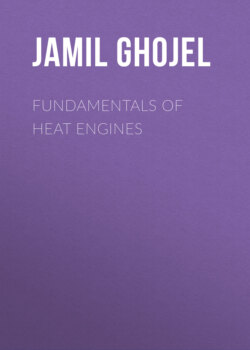Читать книгу Fundamentals of Heat Engines - Jamil Ghojel - Страница 63
1.3.9 Third Law of Thermodynamics
ОглавлениеThis law, based on empirical evidence, postulates that absolute entropy of a pure crystalline substance in complete internal equilibrium is zero at temperature zero degree absolute. The third law allows the determination of absolute entropies from thermal data.
The entropy change of a gas on molar basis is
The entropy change for process 1–2 is then
(1.94)
If the specific heat Cp is assumed constant, Eq. (1.94) becomes
(1.95)
More accurate results can be obtained if the variability of specific heat with temperature is accounted for. Taking the absolute zero as the reference temperature, can be defined as
(1.96)
The values of are usually calculated for different temperatures and can be found in tabular form as s0 = f(T) in most thermodynamic reference books. Using Eq. (1.96), we can write
(1.97)
Substituting Eq. (1.97) in Eq. (1.94), we obtain
(1.98)
As Eq. (1.98) shows, entropy changes with both temperature and pressure. When using Eq. (1.98) in chemical reactions, the pressure ratio in the last term is replaced by the mole concentration of each substance.
The data for some commonly used gases in heat engine practice such as CO2, CO, H2O, H2, O2, and N2 are tabulated in Appendix A. They can be calculated to a very high degree of accuracy for the temperature range 100–6000 K by third‐order logarithm functions of the form
(1.99)
The coefficients of correlation Eq. (1.99) for six gases are given in Table 1.3.
Table 1.3 Coefficients of Eq. (1.99) for the calculation of of combustion products, pref = 0.1 MPa Tref = 0 K.
| , kJ/kmole.K | ||||||
| Coefficient | CO2 | CO | H2O | H2 | O2 | N2 |
| a | 269.772 6 | 234.929 1 | 233.305 3 | 166.044 4 | 243.729 9 | 228.592 9 |
| b | 53.720 45 | 33.106 85 | 42.087 92 | 30.813 48 | 34.405 98 | 32.655 06 |
| c | 4.955 586 | 1.661 032 | 4.707 912 | 2.022 13 | 2.175 759 | 1.661 282 |
| d | −0.617 24 | 9.19E‐02 | 0.667 926 | 0.447 018 | 0.197 82 | 0.150 999 |
As for air, the following modified function (Rivkin 1987) can be used for the temperature range −50 to 1500 °C with the constant coefficients shown in Table 1.4:
(1.100)
Table 1.4 Coefficients of Eq. (1.100) for the calculation of of air.
| B n | ||||||||
| A | B 1 | B 2 | B 3 | B 4 | B 5 | B 6 | B 7 | B 8 |
| 29.44 | 230.18 | −1.61 | −5.99 | 22.94 | −24.56 | 12.98 | −3.48 | 0.38 |
Finally, if the second law of thermodynamics can be stated as the law of degradation of energy, then entropy can be regarded as the measure of the degree of energy degradation.
